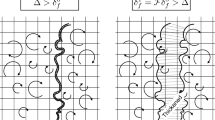Abstract
The high order Spectral Element Method is used to solve the reaction-diffusion-advection problem as described by the premixed flame case. An h–p adaptive refinement-coarsening algorithm is developed based on a posteriori error estimators. Simulations of the wrinkling of a premixed flame front are used to illustrate how the mesh is adaptively refined. A similar, idealized heat transfer problem is used to show the adaptive refinement and coarsening of the mesh. Adaptivity efficiently provides high resolution in areas of the domain where large or rapidly varying physical changes exist, while saving unnecessary computation where the solution is smooth or physical phenomena have passed by.
Similar content being viewed by others
REFERENCES
Ashurst, W. T., and Sivashinsky, G. I. (1991). On flame propagation through periodic flow fields. Combust. Sci. Technol. 80, 159–164.
Embid, P. F., Majda, A. J., and Souganidis, P. E. (1994). Effective geometric front dynamics for premixed turbulent combustion with separated velocity scales. Combust. Sci. Technol. 103, 85.
Henderson, R. D. (1999). Adaptive spectral elements methods for turbulence and transition. In Barth, T. J., and Deconinck, H. (eds.), High-Order Methods for Computational Physics, Springer, pp. 225–324.
Khouider, B., Bourlioux, A., and Majda, A. J. (2001). Parameterizing turbulent flame speed. I. Unsteady shears, flame residence time and bending. Combust. Theory Model. 5(3), 295–318.
Khouider, B., Bourlioux, A., and Majda, A. J. (2001). Parameterizing turbulent flame speed. II. Application to jets and eddies. To be submitted to Combust. Theory Model..
Maday, Y., Mavriplis, C., and Patera, A. T. (1989). Non-conforming mortar element methods: Application to spectral discretizations. In Domain Decomposition Methods, pp. 392, SIAM, also ICASE Report 88–59.
Majda, A. J., and Souganidis, P. E. (1994). Large scale front dynamics for turbulent reactiondiffusion equations with separated velocity scales. Nonlinearity 7, 1–30.
Mavriplis, C. (1990). A Posteriori error estimators for adaptive spectral element techniques, Notes on Numerical Methods in Fluid Mechanics, Vieweg, Vol. 29, p. 333.
Mavriplis, C. (1994). Adaptive mesh strategies for the spectral element method. Comput. Methods Appl. Mech. Engrg. 116, 77–86.
Mavriplis, C., and Hsu, L.-C. (1997). A two-dimensional adaptive spectral element method, Proceedings of the 13th AIAA Computational Fluid Dynamics Conference, Snowmass.
Patera, A. T. (1984). A spectral element method for fluid dynamics: Laminar flow in a channel expansion. J. Comput. Phys. 54, 468.
Peters, N. (1986). Laminar flamelet concept in turbulent combustion, 21st Symp. (Int.) Comb., The Combustion Institute, 1231.
Williams, F. A. (1985). Combustion Theory, Benjamin Cummings, Menlo Park, CA, Chap. 10, pp. 373–445.
Williams, F. A. (1985). Turbulent combustion. In Buckmaster, J. (ed.), The Mathematics of Combustion, SIAM, Philadelphia, Chap. 3, pp. 97–131.
Zel'dovich, Y. B., Barenblatt, G. I., Librovich, V. B., and Makhviladze, G. M. (1985), The Mathematical Theory of Combustion and Explosions, Consultants Bureau, New York, Chap. 4, pp. 278–0307.
Author information
Authors and Affiliations
Rights and permissions
About this article
Cite this article
Feng, H., Mavriplis, C. Adaptive Spectral Element Simulations of Thin Premixed Flame Sheet Deformations. Journal of Scientific Computing 17, 385–395 (2002). https://doi.org/10.1023/A:1015137722700
Issue Date:
DOI: https://doi.org/10.1023/A:1015137722700




